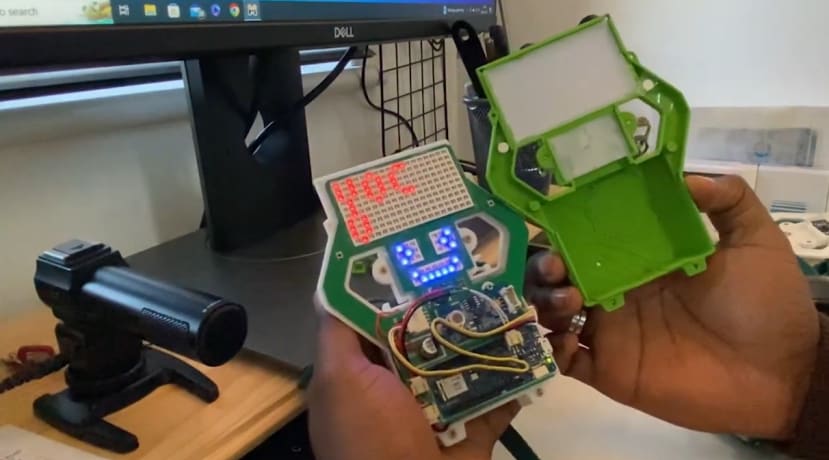Mindful Droid: Vlog 2 - What to Expect from Phase Two?
Follow articleHow do you feel about this article? Help us to provide better content for you.
Thank you! Your feedback has been received.
There was a problem submitting your feedback, please try again later.
What do you think of this article?
My aim is to create a more user-friendly and accessible device for monitoring air pollution, addressing concerns such as complex components, poorly placed cables, and battery life limitations.
Let's start by revisiting the initial Mindful Droid prototype. It featured a display with addressable LEDs, which represented pollution levels through smiley faces. The air quality sensor monitor was connected to the Droid, providing real-time information and encouraging users to understand and address pollution issues. Additionally, the device could measure vehicle emissions NO2 outdoors, offering valuable data on pollution levels in the surrounding area and also monitor for CO2 levels indoors.
Below are some of the listed problems with the first Mindful Droid;
Complex Components and Soldering: One of the primary challenges I faced with the first Mindful Droid was the complexity of its components and the need for extensive soldering. This made the assembly process intimidating for users with limited technical expertise. To address this issue, I am working on simplifying the components and exploring alternative methods of connection that do not require intricate soldering (place and pin). By streamlining the assembly process, we hope to make it more approachable for users of all skill levels.
Poor Cable Placement: Another challenge encountered was the placement of cables, which often protruded from the device, causing inconvenience and potentially affecting the durability of the device. I will be addressing this issue by redesigning the internal structure to ensure proper cable management and secure placement. This will not only improve the device's aesthetics but also enhance its functionality and ease of use.
Battery Life Optimisation: The first Mindful Droid experienced limitations in battery life, primarily due to certain sensors (NO2) consuming a significant amount of power. This affected the overall usability and performance of the device, requiring frequent recharging. To overcome this challenge, I am working on optimising power consumption by selecting energy-efficient components and implementing power-saving measures. The goal is to extend the battery life, allowing users to utilize the Mindful Droid for more extended periods without interruption.
The Vision for Mindful Droid Phase Two - Simplicity and Modularity:
The goal is now to create a more visually appealing device with a simplified internal structure that can be easily understood and assembled by users of all ages and limited technical backgrounds. I want to make the components easier to comprehend, both internally and externally.
The process of building the Mindful Droid will have a STEAM educational element, where users learn trivia facts about the sensors they are putting together, what it does and their benefit (Learn and Play).
By adopting a more modular approach, users will have a better understanding of how the device works and be able to assemble it with ease. This shift will encourage activist engineering and citizen science participation, ensuring that the device is accessible to primary school children and adults alike.
By empowering individuals to build their own devices, I hope to create a sense of ownership and encourage active engagement in combating air pollution. It's essential that everyone can grasp the effects of air pollution and play their part in submitting data to drive policy changes.
I will be sharing how I intend to technically resolve these problems listed above in upcoming blogs and I welcome views opinions and suggestions towards this project.
Follow Michaels's weekly progress in developing the Mindful Droid.



Comments